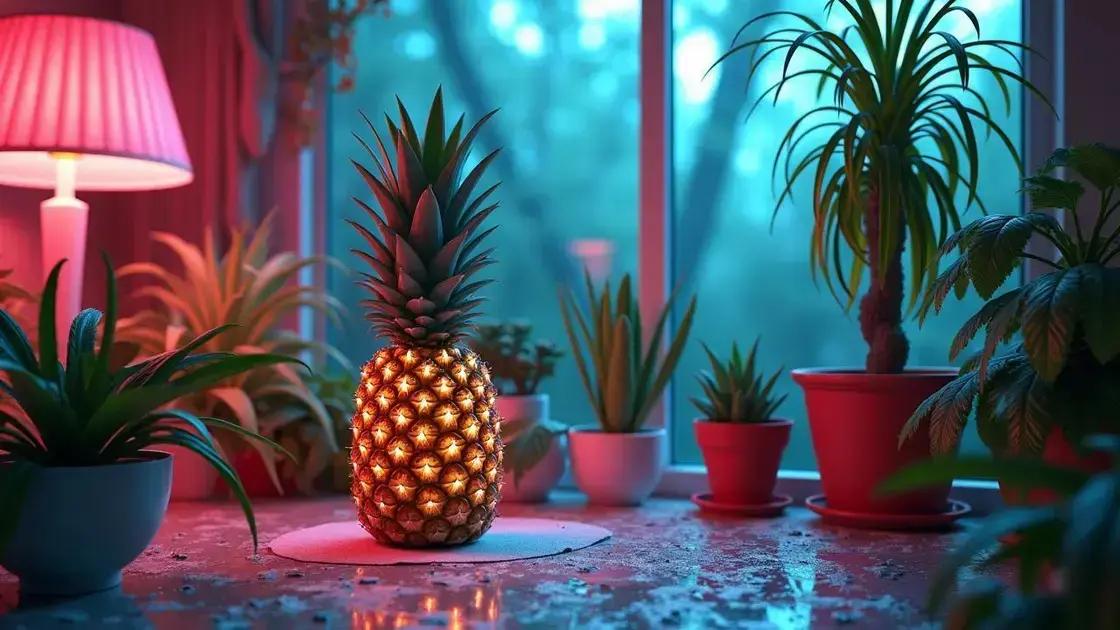How to Care for Pineapple Plant Indoors: 7 Essential Tips for Success
How to care for pineapple plant indoors can seem daunting, yet with the right approach, these tropical beauties can thrive in your home. Imagine welcoming a fragrant slice of the tropics to your space while enjoying the satisfaction of nurturing your very own fruit-bearing plant!
Table of Contents
ToggleUnderstanding the light requirements for your pineapple plant
Understanding the light requirements for your pineapple plant is crucial for successful indoor growth. Pineapple plants thrive in bright, indirect sunlight, making them perfect for sunny windowsills. The right light conditions will help your plant develop strong leaves and encourage fruit production.
The following guidelines will help you provide the best lighting for your pineapple plant:
- Direct sunlight exposure: Avoid placing your pineapple plant in direct sunlight for long periods. While they enjoy bright light, excessive direct sunlight can scorch the leaves.
- Indirect sunlight: A south-facing window offers ideal conditions, as it allows plenty of indirect light. If you lack such a window, consider a sheer curtain to diffuse the light.
- Grow lights: If natural light is limited, using LED grow lights can supplement your pineapple plant’s needs. Choose a grow light that mimics natural sunlight for best results.
Optimal light duration
Pineapple plants require about 12-14 hours of light per day. To achieve this:
- Keep the plant near a window during the day.
- Use a grow light if natural light is insufficient, especially during winter months.
- Rotate your pineapple plant occasionally to ensure all sides receive adequate light.
Signs of insufficient light
Monitoring your plant will help adjust the light conditions as needed:
- **Thin, elongated leaves:** This often indicates the plant is stretching towards the light source.
- **Dull color:** Healthy pineapple leaves should be vibrant. Dullness can signify inadequate light.
By understanding the light requirements for your pineapple plant, you set the foundation for its success. Learn more about exploring indoor gardening techniques for other plants to enhance your indoor gardening skills.
Essential watering techniques for indoor pineapple care

Essential watering techniques for indoor pineapple care are crucial for the health and growth of your plant. Proper watering practices ensure that your pineapple plant thrives and retains its vibrant leaves. Too much or too little water can lead to issues such as root rot or dehydration.
Understanding the watering needs
When it comes to watering pineapple plants, it’s essential to consider several factors, including humidity, pot size, and the current growth stage.
- Humidity levels: Pineapples prefer moderate humidity. If your indoor environment is dry, consider misting the leaves occasionally.
- Pot size: Ensure your pot has drainage holes to prevent excess water accumulation.
- Growth stage: Young plants may require less water compared to mature plants that are actively growing or fruiting.
Steps for effective watering
To maintain the right moisture level, follow these steps:
- Check the soil moisture by inserting your finger into the soil up to about an inch. If it feels dry, it’s time to water.
- Water the plant thoroughly until you see excess water draining from the bottom of the pot.
- Allow the plant to dry out slightly between waterings. Pineapples prefer to be on the drier side rather than overly saturated.
Signs of overwatering and underwatering
Recognizing the signs can help you adjust your watering technique:
- Overwatering: Yellowing leaves and mushy roots indicate too much water.
- Underwatering: Brown, crispy leaf tips and a wilting plant suggest the need for more water.
Incorporating these essential watering techniques for indoor pineapple care can lead to a bountiful and healthy plant. For further guidance, consider exploring indoor gardening techniques tailored to your needs.
Choosing the right soil for healthy pineapple growth
Choosing the right soil for healthy pineapple growth is vital for nurturing your indoor pineapple plant. The right soil ensures proper drainage, aeration, and essential nutrients, which are crucial for the development of strong roots and vibrant foliage.
Characteristics of ideal soil
When selecting soil for your pineapple plant, consider the following characteristics:
- Well-draining: Pineapples prefer soil that drains quickly to prevent root rot.
- Lightweight: A lighter soil mix allows for better airflow to the roots.
- Nutritionally balanced: Ensure the soil contains the necessary nutrients for your pineapple’s growth.
Recommended soil mixes
Here are some suitable soil options for your pineapple plant:
- Cactus mix: This is an excellent choice due to its excellent drainage properties.
- Potting mix: An all-purpose potting mix combined with perlite or sand can also work well.
- Homemade blend: Consider mixing equal parts garden soil, coconut coir, and sand for an ideal balance.
Tips for maintaining soil health
To ensure the longevity of your soil’s health, implement these practices:
- Periodically replace the top layer of soil to introduce fresh nutrients.
- Avoid over-fertilization, as it can lead to nutrient burn.
- Test soil pH every few months; pineapple plants thrive in slightly acidic conditions (pH 5.5-6.5).
By thoughtfully choosing the right soil for healthy pineapple growth, you contribute to the overall success of your indoor gardening experience. For additional insights, consider exploring indoor gardening techniques designed for optimal plant care.
In conclusion
Caring for your indoor pineapple plant involves understanding its light, watering, and soil requirements to ensure it thrives in your home. By providing the right conditions, you can enjoy not only the beauty of the plant but also the rewarding experience of growing your own pineapple. Remember that maintaining a healthy environment and consistent care are key to success. For more insights, check out tips on enhancing your indoor garden to further expand your gardening skills and knowledge.

